
Sydney Rows
A Centennial History of the Sydney Rowing Club, 1970, by A L May
Table of Contents
Chapters
- Preliminaries: before 1870
- Foundations: 1870-1880
- New Clubs: 1880-1890
- The Amateur Question: 1890-1900
- Sydney on Top: 1900-1910
- Henley and War: 1910-1920
- Pearce and Mosman: 1920-1930
- Financial Problems: 1930-1940
- War and Wood: 1940-1950
- Strength and Stability: 1950-1960
- On Top Again: 1960-1970
Appendices
4. The Amateur Question: 1890-1900
Racing
The first rowing season of the new decade was full of interest. It opened with Sydney's own regatta with the four races-junior four, double sculls, maiden pair and trial eights-taking place off the new city club house rather than on the Parramatta as had been the case for many years. A special eights race was conducted in Sydney shortly afterwards, with a four-oared outrigger as the prize. Mercantile easily beat University in the event, there being no other starters.
The Association decided that one man only should select the 1890 intercolonial eight, and Goodyear both won the ballot and survived a later recision motion. Many established oarsmen were not invited by him to row and others who were declined.
Goodyear finished with a crew largely of heavy and untried men, including two from Sydney, W. Moore and A. E. Hopgood. A week before the race, the crew was said to have "neither pace nor condition". In the event itself, NSW was thrashed and failed to finish. Victoria went past Searle's monument first once again, with Queensland 2 1/2 lengths back in second place.
Sydney put a crew together for the 1891 Lane Cove Challenge Eights at the St. Ignatius' Regatta, but they finished well back in fourth place behind Mercantile, Glebe and East Sydney. A few weeks later, the Association's regatta was conducted, with the champion senior eights having attached to it, for the first time, the Association's championship pennant (the idea of its very keen and able honorary secretary, Arthur Holmes).
Sydney won both the maiden four and maiden eight at the regatta, but the senior eights was a repeat of St. Ignatius' with Mercantile winning by 4 lengths. Drama was to follow: after a protest - and long discussion - the RA declared the event "no race". A member of the Mercantile crew had rowed for a money prize some years before (and disqualification of the crew would have meant other contestants would have lost their amateur status through having rowed against him).
The usual result transpired: Mercantile resigned from the Association, arguing principally that the protest had been received too late to be considered. Requests by the RA for reconsideration were unavailing and it was not till July 1893 that Mercantile rejoined.
An open race was included on the programme for Sydney's annual regatta in August, 1891 for the first time. It was for senior double sculls and the club's crew of Nick Johnson and Gerald Kennedy rattled home by 3 lengths from Bill Goulding and James Smith of East Sydney. The regatta itself was the usual social success, with the committee taking all pains to ensure the comfort of the lady visitors. A fund-raising regatta was conducted by the Association in October and Sydney secured an easy win in the senior fours. Mercantile was absent-but through choice, because withdrawal from the Association did not mean its crews were unable to enter.
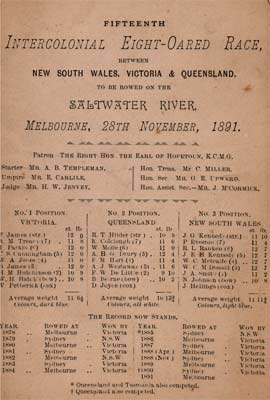
1891 Programme
Queensland scored its first intercolonial win in the 1891 event. It had even attempted to have the race held in Brisbane, thus raising the question of whether the race was only between NSW and Victoria with other colonies participating by invitation or not. Queensland also strongly urged a reduction in the distance of the race to two miles and the holding of regular races for fours and pairs as well. Although NSW favoured the latter proposal, all suggestions proved abortive.
Myers and Oatley were invited to select the NSW crew together with their selected stroke, Gerald Kennedy. Four more Sydney men, Ted Kennedy, R. Ranken, Nick Johnson and W. C. Metcalfe, gained selection, along with two Mercantile men and one from East Sydney. Johnson was thus in his seventh intercolonial since 1882.
Half the cost of a new boat was subscribed by the generous president of the Association and, in gratitude, the boat was named the George Thornton. The race was rowed in Melbourne, and Queensland beat NSW, coached by Myers, by 3 lengths with Victoria, coached by Upward, 2 lengths back third. The VRA, it may be noted, was still taking no part in the organization of the races, although being keen to organize an eight-oared race with the other colonies under its own amateur definition.
The next intercolonial race was held only six months later and, this time, in Brisbane. The NSWRA selected three men to pick the crew: Dobson and Johnson of Sydney and Robertson of Glebe. At the same time, Upward informed the RA that his committee would disband after the Brisbane event to allow the VRA to take over the race under the definition adopted at the Sydney conference of 1888. The final NSW crew contained three Sydney men, Moore, Braddon and Aldworth, while North Shore (which had just resigned from the Association) supplied two, University two and Balmain one. The one-armed Sid Hellings was chosen as coxswain and Johnson as coach. In Brisbane itself, the NSW crew did well and went down to Victoria by only 1/2 length with Queensland, this time, a long way back.
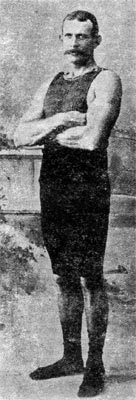
M J Slack
A championship sculling race was won by M. J. Slack of Queensland, with Lambert and Goulding of NSW second and third. The eights' result drew forth one comment that bad management could be blamed for the NSW lack of success, the reasons being that the colony had seldom been represented by the best men, unfit oarsmen had often been selected and certain clubs had been favoured by the selectors.
East Sydney stood out in senior rowing in the 1892/93 season. The club won the senior eights, the open event, at Sydney's own regatta, Sydney itself being 1 1/2 lengths back second and Mercantile third. East Sydney, stroked by Goulding, repeated the win over Sydney's much heavier crew at St. Ignatius' and again at the Association's regatta, thus winning the championship pennant and the gold medals that went with it. Mercantile staged its own annual regatta on the same day as that of the Association and it was supported by North Shore and Parramatta, both now outside the RA. The associated clubs decided amongst themselves not to compete against non-associated clubs, and all the former withdrew from the Anniversary Regatta of 1893.
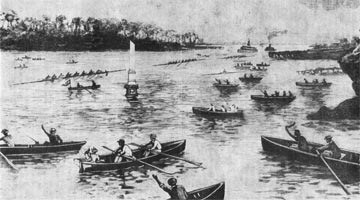
Finish of the 1893 Intercolonial Race
NSW was forced to compromise over the 1893 intercolonial event. The VRA had determined to continue the intercolonials provided they could use manual labour men. NSW, faced with the probability that a separate race would be arranged, invited all colonies to row on the Parramatta in April under their own definitions of an amateur. The ballot for NSW selectors was won by Johnson, McDermott of University and Smith of East Sydney, with Johnson being named coach for the second year. Ted Kennedy, whom many now thought was past his best, gained selection as did Cadell of Sydney. Goulding gained the bow seat along with two other East Sydney men, two from North Shore and one from Glebe.
The crew trained from SRC, making use of the Samuel Hordern. Victoria was strongly favoured but NSW rowed a "long telling stroke" to beat them by 4 to 5 lengths with Queensland a further 5 lengths behind third. A meeting of the Association decided to adopt the Victorian custom and to present the crew with their blades, painted light blue and lettered in gold.
The St. Ignatius' Regatta, with the very handsome and valuable Gold Cup itself at stake for the first time, was held only a week later. North Shore won by 2 lengths from Sydney with Glebe well up third and both East Sydney and Mercantile well back. The regatta itself was a great success: "such cheering and enthusiasm has seldom, if ever before, been noticed at an amateur meeting". Nine crews fought out the maiden fours, presenting a wonderful sight.
More haggling over the amateur definition preceded the 1894 intercolonial event. The VRA drew up a set of rules to govern intercolonial races late in 1893, one rule being that oarsmen from each colony would conform to the 1888 definition. This was amended, however, to read that each colony would use only oarsmen recognized as amateurs under its own rules. NSW had thus agreed not to use manual labourers even though other colonies continued to be free to do so. It was further agreed that the race would take place in each of the three colonies by rotation. Failure to be represented in any year would, however, mean forfeiture of that colony's next turn to conduct the race.
The NSW champion eights had been won by North Shore in October, 1893 and Lou Quist, the winning coach, was made coach of the intercolonial crew. The selectors, the successful 1893 team again, retained five of the previous year's crew with Cadell and Kennedy amongst those missing out. Sydney gained representation, however, through Aldworth and their new champion, Ted Pearson. The race was rowed in Melbourne and in a very fast time. Victoria drew away to win well from NSW with Queensland never in it.
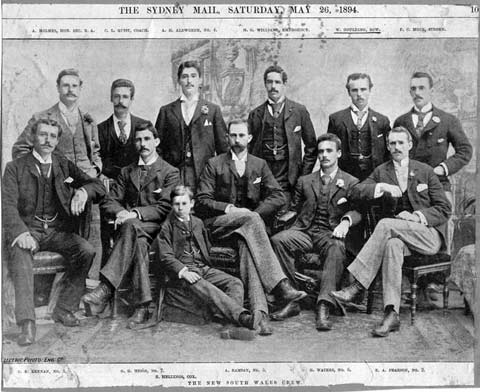
1894 NSW Intercolonial Crew
Back row (left to right): A Holmes (Secretary NSWRA), C L Quist (Coach), A H Aldworth, H G Williams, W Goulding, F C Moor. Front row: C R Keenan, G G Higgs, A Ramsay, H Waters, E A Pearson. In front: S Hellings (cox).
Sydney was fast becoming a major force in senior rowing once again, despite the fact that only one member of its eight had won a senior race. In the champion eights at the Association's regatta in October, 1894, Sydney was beaten by North Shore by a length only. At the club's own regatta soon after, an open race was placed on the programme for oarsmen who had never won a senior race. Sydney duly won and, with a little help from the conditions, followed up with a win by 2 lengths from North Shore in the Gold Cup a week later. The successful crew was C. H. Pearson (bow), C. H. Kloster, H. Y. Braddon, R. Ranken, W. C. Metcalfe, J. E. H. Kennedy, H. G. Williams and E. A. Pearson (stroke). The 1895 Gold Cup was rowed in March and was the next major test of strength. In a close finish, North Shore won from University and Sydney.
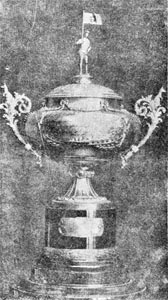
Riverview Gold Cup
The 1895 NSW intercolonial eight "mutinied". The crew was selected by Johnson, Ted Kennedy and Quist, the latter also becoming coach. The two Pearsons and Williams gained selection, Ted Pearson being the only survivor of the previous year's crew. Nevertheless, it was described as "a good, dashing, light team, full of life and strong".
The crew's ability was, however, soon to matter very little. The NSWRA discovered some days before the race itself that a member of the Victorian eight had cycled for cash prizes. In doubt as to where this placed the NSW rowers, the Association instructed the NSW crew in Brisbane not to start unless the offender was withdrawn.
The cash cyclist, R. E. Dawson, started and, in a "gross breach of discipline", the NSW crew "mutinied" and decided to row. Victoria won the actual race, beating NSW by a length only. Two problems now faced the NSWRA: how to discipline the crew and, in any event, were they still amateurs? The Association also protested to the VRA, demanding a "no race" decision. The Queensland Rowing Association took the view that each Association had to interpret its own rules and, accordingly, asked the VRA if its rules allowed a cash cyclist to row as an amateur. Victoria quickly announced that they did.
The NSW Association decided to consult the Amateur Rowing Association of England for its view on the matter and it proceeded to pass a vote of severe censure on its own crew. The Association also decided that all members had forfeited their amateur status through having competed against a professional and that a new rule would be needed to overcome the position. A later meeting reinstated all the oarsmen concerned to amateur status. Queensland suggested a further conference on the question of managing intercolonial racing, but there seemed to be insufficient time before the next race was due. And could NSW race against a further crew selected by Victoria under its own rules? In due course, advice was received from the English ARA that it had considered the matter and agreed that the action of NSW was justified and that the Victorian oarsman was not an amateur under Victoria's rules.
Rowing in Sydney was, meanwhile, continuing. University took the champion eights in 1895, beating North Shore and East Sydney with Sydney not a starter. Sydney had two open races on its own regatta programme and won them both-the maiden eights and the senior pairs (Ted Pearson and Williams).
With the intercolonial coming up fast, NSW informed Victoria that unless they ensured that none of their crew had competed for money prizes in any branch of athletics, NSW would not meet them. Victoria urged NSW not to disturb the existing agreement, to row the forthcoming race under the established system and to refer all questions in dispute to a further conference.
Selectors for the 1896 crew were McDermott, Ted Kennedy and F. C. Williams of Glebe. They chose five University men, but Ted Pearson and Williams also gained selection. Pearson was stroke and gained much praise for his work while Williams was described as being "a splendid worker, tough as can be found, very strong and can stand any amount of work". While the 1895 crew had had to use a Glebe eight that was seven years old, the 1896 crew, due to the generosity of Miss Eadith Walker, rowed in The Yaralla, a brand new racing eight built by Rough of England, and used Ayling oars. In the race itself, Victoria led all the way, although NSW finished strongly to cut the winning margin down to a length. Queensland stopped around Cabarita, when about 10 lengths behind.
